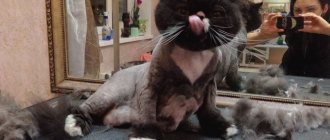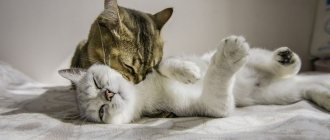If the cat's behavior after mating causes concern in the owner, it is better to show the animal to a veterinarian rather than let the situation take its course. A female cat that has no health problems should become pregnant after mating. Usually the pet calms down and prepares for a new role. But if pregnancy does not occur, and a new estrus begins untimely, the owner should find out the reasons for this disorder and, under the supervision of a veterinarian, try to eliminate them.
What to do for successful mating?
Time it right
Cats reach sexual age at 7-8 months. However, it is better to mate a cat when she reaches 1 year, having missed 2-3 heats. Mating at an earlier age is undesirable, since the animal has not yet matured physiologically and is not ready for pregnancy. You should also not breed a female after one and a half years, as she may not let the cat near her. It is better to mate a pet during the estrus stage, when the cat is ready for fertilization. This is day 2 or 3 of estrus. You can tell that the pet is ready by its raised tail, swelling of the external genitalia, calling cry, and raised butt. You can tell that the mating was successful and the cat is pregnant by swelling of the nipples, cessation of estrus, drowsiness, and loss of appetite.
Responsibility of the parties
Mating of outbred animals does not involve payment, while purebred cats and female cats are mated for the purpose of producing offspring only after clear agreements. Before mating, the owners of the “groom” and “bride” can draw up an agreement, which describes the characteristics of the animals, prescribes the conditions for the cat’s stay in the cat’s territory, and determines the amount and method of payment. A standard mating agreement can be provided at the felinological club. It is accepted that the cat owner must pay - the cat owner receives either the agreed amount or a portion of the kittens. All nuances, for example, if pregnancy did not occur or the mating was unsuccessful, are discussed in advance.
Our recommendations will help keep the knitting process under control already at the preparation stage. Well, if nothing came of the meeting of two cats, then it’s worth arranging a mating with another cat.
Symptoms of the onset of labor
Early warning signs of childbirth are sagging of the abdomen as a result of relaxation of the ligaments, as well as retraction of the sacral region.
On the eve of delivery, swelling of the genital organs and mammary glands occurs, and droplets of colostrum are released. Viscous mucus without pathological impurities comes out of the loop.
When labor occurs, the water breaks, releasing a grayish-pink fluid. Then contractions appear, which normally last for an hour, which, if the outcome is favorable, end with the birth of offspring.
When and how to breed males and females
Signs of readiness for mating
- There are sexual and physical maturation. A cat comes into heat at 7–9 months (the dates may change), but the body is not yet ready for mating. The onset of puberty depends on the breed, season of birth, living conditions, feeding, and physiological characteristics.
- In cats, estrus lasts 5–10 days. Readiness for mating is determined by behavior: animals rub against the legs of their owners, various objects, become restless, meow, or lie in silent suffering. This stage (proestrus) lasts the first 2 days. But the female is not yet ready to mate and will not allow the cat to approach her.
- The second stage of sexual receptivity (estrus) lasts for the next 3–5 days. The cat makes inviting cries, rolls on the floor, and does not want to eat. When stroked on the back, she withdraws her tail, presses herself to the floor, moves her hind legs and raises her croup. At this stage, fertilization can occur.
- In cats, puberty occurs at almost one year of age and is characterized by aggressive behavior. In early spring, they actively scream, calling for females.
- A pet living in an apartment accumulates testosterone due to lack of regular mating. As a result, he screams at night, giving no rest to his owners, marking the territory, and the urine acquires a sharp and unpleasant odor.
If mating a cat is not part of the owner’s plans, it is better to sterilize the pet so as not to torment him and to find peace for the whole family.
First mating
The best time for mating a female cat is the beginning of spring. A hormonal surge occurs, and favorable conditions arise to bear and nurture offspring.
This usually happens at 1–1.5 years. It is important to correctly determine at what age an animal can be allowed into mating. Early mating is undesirable: in cats, reproduction is reduced; in cats, complications during childbirth, death of offspring or infertility are possible. It is advisable to breed a cat no earlier than her third heat.
But you shouldn’t delay mating either: late matings have a negative impact on the mental state. To prevent a cat from screaming for days and showing aggression, you need to try to untie it until it is 2–2.5 years old. If puberty occurs at 5–6 months and manifests itself intensively and regularly, the cat is mated without waiting for the optimal age.
What other cases are there?
The signal that the female is ready for mating is estrus. How do you know if your pussy has started sexual intercourse? She experiences obvious “languor”:
- purrs often and loudly;
- fawns or turns into an aggressive touch-me-not;
- rubs vigorously against all sorts of objects;
- takes a characteristic pose when stroking the back: the trembling tail is pulled to the side, the rear is raised, the chest falls to the floor.
The “lady” is sent to the “gentleman” on the third day after such signs appear. The guest comes with her things: food, bowls, litter tray. No one knows how long it will take to breed a cat and a cat. You need to plan for 1-3 days. The first time it may take a week.
Meeting partners rarely takes place in a warm, friendly atmosphere. Mutual ignoring, hissing, fighting are typical manifestations of cat flirting. The owner of the house should monitor the situation to prevent injury to animals.
When the “lady” gets used to it, she herself begins to flirt with the male. After waiting for the aggression to die down, you need to leave the “newlyweds” face-to-face. How long does a coitus session last? Usually “this” occurs in cats for up to 20 seconds, accompanied by heartbreaking screams. How long after can I visit my clients? It’s worth delicately waiting a couple of minutes for the disturbed duo to calm down.
We suggest you read: Diseases of peacocks and their treatment
How to understand that genital contact has occurred? Silence reigns in the room where the “young” remain. After being untied, Murka's behavior changes dramatically: she becomes tolerant of her partner, lies down next to him, rolls around on the floor, her genitals enlarge and turn red.
How many days does mating last for cats? It all depends on the character and experience of the “newlyweds”. Ambitious murki behave aggressively, shy ones huddle in a corner. The boyfriend must be given time to seduce the “lady”.
In veterinary practice, there are a number of specific cases when the sex hormonal background of a sterilized individual was determined by diseases occurring in the thyroid gland. Aligning and adjusting the balance of hormones in this situation is not an easy task, which may include a number of stages:
- Exclusion of hormone-producing tumors;
- Chemical suppression of sex hormones.
Most often, the latter is performed by implanting a special capsule under the skin.
Signs by which you can understand that a cat is pregnant after mating
Sexual maturity in a domestic cat occurs at 6 - 7 months, in a cat at 9 - 10. The period depends on the time of year, breed and individual characteristics of the body. By this age, the animal has not yet reached physiological maturity and will not be able to produce full-fledged offspring. The most suitable age for reproduction is one and a half years. Therefore, it is not advisable to breed during the first heat. A domestic cat is capable of mating and producing kittens 2–3 times a year.
Estrus appears in February - March, the next activity occurs in the summer months. Repeats after 2 weeks if pregnancy does not occur during mating. When breeding purebred animals, mating after reaching 8 years of age is not recommended.
HOW MANY KITTENS CAN A CAT GIVE BIRTH AT THE FIRST TIME?
On average, a cat will give birth to 1-6 kittens per litter, and this can depend on various factors. This is often influenced by the characteristics of the body, and even more often by the state of health of the animal. Cats have a bicornuate uterus, the horns of which contain fertilized eggs at the beginning of pregnancy. They attach to the walls of the uterus.
Since “space” is limited, more than 6 kittens are very rarely born in one litter.
The first birth is different in that during it cats give birth to no more than 3 kittens.
We will learn about the character of a British cat, discuss its features. We will tell you how long pregnancy lasts in cats: and find out the details.
By the way, the same feature is found in old cats. In general, in old age, these animals rarely give birth, but they can love other people’s kittens like mothers and even “adopt” them.
Demonstration of trust
A satisfied and calm cat in its territory playfully rolls from side to side, gracefully stretches out and squints its eyes. At the same time, her muzzle radiates bliss and serenity - this is how an animal invites a familiar person to careful caresses and gentle stroking.
A sign of friendship and goodwill towards a person or fellow tribesman for a cat lying on its back is the stretching of its front paws with soft pads.
Mating process
When a cat goes into heat, her behavior undergoes changes. She demonstrates her readiness for mating in the form of loud meowing, rolling on the floor, lifting her tail to the side, and arching her back. She takes the same body position during intercourse. The cat settles on top, clinging to the withers with its teeth. The paws are located on the sides.
Classic position during mating
It all starts with foreplay. The cat approaches the female, sniffs her and purrs gently. Most cats at this moment drive the cats away, hissing and waving their paws. The male retreats, but not for long. Then the attempt is turned again. And so on until the cat agrees to mating.
The sexual contact itself lasts 15-25 seconds. During the ejaculation process, the cat makes a loud sound. This is explained by the presence of spines on the penis (to stimulate ovulation). The cat at this time pushes her away from him. The pet may show aggression towards its lover. Therefore, he must quickly run away and hide.
Next, the female will begin to actively roll around on the floor, then will lick the genital area. Some cats are not ready for secondary intercourse. It is possible to repeat sexual contact only after 3-7 attempts. There can be a lot of matings. Therefore, there is no point in doubting that the cat will become a mother in 9 weeks (if the groom’s reproductive organs are fine).
How to prepare for the birth of a cat can be read in our article.
The first thing the cat will do is start licking itself.
Ideally, mating is best done on day 3 of the cycle. Here the probability that ovulation will occur is almost 100%. Some people practice mating within 3 days of the start of estrus, which is also quite effective.
Cat behavior after mating
It’s worth saying right away that mating is a very energy-consuming process for a cat. Several days of loud meowing, lying on the floor, multiple sexual contacts can leave their mark on the female’s well-being.
Therefore, the animal may feel tired, hide in a corner, crawl under the sofa and simply sleep quietly for several days. If the pet comes out of the “nest”, drinks water, eats, and goes to the litter box, then everything is fine, there should be no reason for concern.
The cat is clearly tired after mating
An increased appetite in a furry pet is also considered normal. During mating, the animal loses a lot of calories and energy, which it tries to replenish by feeding on a bowl of food. Some veterinarians believe that in this way a responsible cat accumulates strength for bearing offspring and subsequent births.
You should not mate a cat with a male at the very beginning of estrus (proestrus). She simply won’t let him near him and may scare him away.
Some pets continue to demand a cat even after numerous sexual intercourses. This process is also easy to explain. It all depends on what day of estrus the intercourse occurred. The fact is that the number of hormones fluctuates throughout the entire period of estrus. Accordingly, the animal’s behavior will change. On average, estrus lasts about 5-10 days. These standards are approximate. The duration may be longer, or it may be shorter.
If sexual intercourse occurred in the first days (from the third to the fifth day of the cycle), then the estrus will last the prescribed amount of time. The body does not perceive pregnancy immediately after fertilization. Therefore, some cats behave at this time as if conception had not occurred and continue to demand a cat for mating.
The cat is still asking for a cat
The owner should not allow the breeding to happen again. This can lead to the fact that fetuses with different dates are fixed in the uterine cavity, which will cause the birth of dead kittens or with developmental abnormalities. For mom, this is also a dangerous process, sometimes leading to exhaustion and other dangerous consequences.
If sexual contact occurs in the middle of the estrus period (5-7 days), then there is a high probability that the pet will calm down and stop demanding a cat. Concern on her part will manifest itself if the duration of estrus is more than 10 days. But the activity will not be the same as in the first days.
You should not immediately remove the cat from the carrier. Let the animal sit there for a while and get used to its surroundings.
If intimacy occurred in the last days of estrus, then the cat will behave calmly. In the last days of estrus, the animal's hormonal levels stabilize. Therefore, 90% of all cats stop being active and demanding a male.
If after mating the cat continues to leak?
After mating, the female may continue to worry for a couple of hours (or even days!), scream, stick out her tail when touching her rump, and lie on the floor. This is a natural process and should not cause concern to owners. The fact is that during the process of estrus, a large amount of sex hormones is released into the bloodstream.
Ovulation begins approximately on the second day (up to 30 hours) after mating. Therefore, it is quite reasonable that the cat will demand a cat for at least 1 more day.
The cat does not yet understand that she is pregnant and continues to roll on the floor
How to understand that ovulation has occurred? Everything is very simple. If the cat is no longer interested in the imported bride, this means that the process of release of the mature egg from the ovaries has occurred and the pet can be safely taken home. The same applies to the aggressive behavior of a cat towards a former lover.
The cat is aggressive against the cat
It is worth noting that the female can demand a “groom” during pregnancy. This process is due to the fact that the level of progesterone in the blood decreases sharply due to pregnancy. Pathological hormonal disruption occurs 3-6 weeks from the day of fertilization. The cat does not realize that she is pregnant, so she will demand to finish the job she started. Coitus should not be allowed during this period. Especially if 60-75 days have not passed since the date of mating.
After mating, the cat secretes mucus from the vagina: is it normal or not?
It is worth saying that mucus released from the vagina after mating is in some cases a normal phenomenon, and in others it is pathological.
Usually, within 2-3 days after intercourse, the cat begins to leak a transparent, viscous secretion. This indicates that the heat is continuing. This process should not cause concern to owners.
You need to sound the alarm when the secreted mucus is red, brown or brown in color and emits a putrid odor. It means:
- inflammation in the genital area due to the development of a bacterial or viral infection;
- miscarriage;
- relapse of chronic diseases of the reproductive organs.
The mating clearly went wrong
Abortion can occur 2-5 days after mating or in the last stages of pregnancy. The reasons may be:
- infectious diseases (plague, chlamydia, toxoplasmosis, brucellosis, etc.);
- non-infectious factors - abnormalities in fetal development, endocrine diseases of the mother, injuries, intoxication, taking drugs that affect the functioning of smooth muscles, hypothermia, overheating, etc.
If cloudy and foul-smelling discharge mixed with blood appears, you should immediately visit a veterinarian.
At the veterinarian's appointment
The causes of the infectious process may be foreign microorganisms present on the cat’s reproductive organ or in the cat’s vagina. The inflammatory process starts when the animal’s immunity is weakened, or there are microcracks on the walls of the vagina. Poor functioning of the body's protective functions leads to increased proliferation of bacteria, which causes the development of endometritis, vaginitis, oophoritis, metritis, etc.
In most cases, infectious diseases lead to miscarriage. Therefore, it is very important, even at the stage of pregnancy planning, to take the cat to the veterinarian and carry out all the necessary tests for the presence of infections.
A caring owner decided to take his pet to the veterinarian
False pregnancy after mating
In cats, unlike their barking cousins, false pregnancies are rare, but they do occur. The reasons are:
- lack of motile and healthy sperm in the cat;
- slight mobility of tadpoles;
- diseases of the genital organs of the manufacturer.
False pregnancy, like normal pregnancy, is accompanied by the following symptoms:
- swelling of the nipples;
- the cat begins to be cautious;
- milk cartons increase in size;
- The pet's belly is rounded.
False pregnancy is very similar to true pregnancy
After the required time has passed, the cat gives birth and milk appears. False pregnancy causes serious stress in the cat, mental disorders, and hormonal imbalances.
To avoid false pregnancy, you should ask the owners of the “inseminator” in detail about his health and previous “victories.”
It’s worth asking about any vaccinations you have received. There have been situations when, after mating, males infected cats with dangerous infectious diseases - feline herpes, distemper, calcivirus, etc.
False pregnancy
It happens that after sterile intercourse, the female’s body reacts as if pregnancy has already occurred. Most often this happens when the inseminator has problems with reproductive function, for example, there are no healthy sperm or their motility is reduced.
The cat begins to behave as if the embryos are developing as expected:
- behavior becomes more cautious;
- nipples swell;
- the stomach increases in size;
- After the end of pregnancy, milk is released from the mammary glands.
This condition is extremely dangerous for a cat: it causes mental stress, severe hormonal imbalance and deterioration of health. To prevent such a situation, you need to select a male who has healthy offspring, carried and born without problems.
Choosing the time period of estrus
Estrus can occur in a hidden form, and the cat will begin to furiously ask for a male cat already on the 4th day. It is important not to make a mistake with the time interval of estrus
The next step is timing during estrus . The cat cannot become pregnant for the first 2 days. It is better to send her to the cat on the 3rd day and leave her for 3 days. The process of ovulation in cats begins after reaching a certain concentration of hormones in the body. One or 2 days of mating is not enough to pump up a certain level of hormones.
Selection of a partner
You can find a partner for a cat either by posting an advertisement - they used to be placed in newspapers, now they appear on social networks and on message boards on the Internet. If the cat is a club cat, then the solution to the problem is to visit the club, where they will help you choose a cat suitable for mating. Remember that you need to start looking for a partner in advance. Naturally, she must have all her vaccinations.
Felinologists recommend breeding a cat for the first time with an experienced cat. But if a suitable “bride” is not found, then you can take an inexperienced one, relying on the strong instinct of procreation.
Cat screams after mating are natural!
Cat screams after mating are a natural occurrence. She can behave this way not only for a few hours after the wedding, but also for several days. At the same time, the cat can not only howl, but also purr and roll on the floor.
This behavior does not at all mean that pregnancy has not occurred, however, you can find out for sure about this only after the first signs appear - on an ultrasound it becomes noticeable no earlier than twenty-one days later.
Some cats are deficient in the pregnancy hormone, which affects the cessation of estrus - in this case, estrus may begin again between the third and sixth week of pregnancy.
Causes for concern
Sometimes owners sound the alarm when a cat, after mating, begins to behave as if she is sick. This is often accompanied by diarrhea or vomiting, and sometimes the temperature rises. There are several explanations for this:
- pronounced reaction to stress (presence of a male or moving, change in hormonal levels, etc.);
- digestive disorders due to a change in diet, if the animal was given to another home for mating without the usual food;
- the onset of toxic infection is possible, which is not associated with attempts to have offspring;
- bacterial or viral infection for which the male has not been vaccinated (calcivirosis, rhinotracheitis, panleukopenia, etc.).
Should there be discharge after mating?
This is where it’s worth going into more detail. The fact is that discharge from the genitals after mating in cats is normal in some cases, but in others it is a very serious signal that there is a pathology in the body.
Usually, another 2-3 days after the cage, you can observe transparent, watery mucus - this is the norm and the result of a still ongoing estrus. This phenomenon should not bother owners.
But the appearance of dirty, brown, viscous discharge mixed with blood and an unpleasant odor is a very bad and unfavorable symptom. What it could mean:
- abortion;
- sexual infection;
- inflammatory processes in the reproductive organs (gynecological diseases).
Abortion can occur at longer periods or just a few days after mating. He can wear:
- infectious etiology, the same sexually transmitted infections (brucellosis, chlamydia, toxoplasmosis, plague);
- and non-contagious, when there are abnormalities of intrauterine development, endocrine disorders (reduced secretion of progesterone), intoxication, the use of drugs that affect the functioning of smooth muscles, various injuries or hypothermia.
With different types of abortion there will be different signs. You can indirectly judge an impending miscarriage by the appearance of dark green discharge mixed with blood. In any case, consultation with a specialist and pelvic ultrasound are necessary to make a diagnosis.
Gynecological diseases arise as a result of the influence of various factors, in particular secondary microflora. Opportunistic microorganisms present both on the male penis and in the female vagina are the cause of opportunistic infections that lead to inflammatory processes in the reproductive organs.
For a healthy animal, the presence of these microbes does not pose any danger. If a cat has microtraumas on the reproductive organs, immunity is reduced, then the natural defense weakens, “foreign” bacteria transmitted by the cat during sexual intercourse begin to multiply rapidly, leading to diseases such as vaginitis, metritis, pyometra, endometritis, oophoritis and etc.
In most cases, gynecological diseases are accompanied by discharge and subsequent pregnancy failure, if it occurs at all. Therefore, it is so important to carry out periodic examinations before mating, to treat the animal in a timely manner for any inflammation, in order to be confident in the health of the pet and her ability to bear healthy offspring.
First contact requirements
A partner for a meowing ward is found in advance. They look through advertisements, go to exhibitions, prepare their pet for the decisive meeting.
Rules for mating cats:
- To avoid dangerous pathologies, estrus cannot be stopped with hormonal or other drugs.
- The first mating of cats requires a fully completed vaccination plan (4 weeks must pass after the last immunization).
- Half a month before intercourse, deworming is carried out.
- On the day of the meeting, the “bride” (as well as the “groom”) have their claws trimmed to avoid injury.
- It is wrong to bathe cats before mating: soap and shampoos muffle the smell of pheromones.
- At the crucial hour, they make sure that the female is moderately well-fed, well-groomed, with clean ears, clear eyes, and a shiny nose.
Mating a cat and its conditions:
- The breeder is supposed to be healthy, vaccinated, treated for worms, and externally well-groomed.
- To stimulate sexual activity, it is recommended to enrich the menu with B vitamins a couple of days before intimacy.
- The cat owner, as the owner of the “mating station”, is obliged to ensure that the meeting is successful: organize an acquaintance, competently stimulate the development of sexual relations, and be responsible for the comfort and safety of the furry guest.
The meeting of a pair of virgins is undesirable. It is fraught with psychological or physical damage.
Behavior immediately after mating
Regardless of the timing of mating, there are characteristic behavioral traits. Upon completion of sexual intercourse, the female sharply pushes away the male and shows pronounced aggression towards him. The degree of aggression depends on the character of the animal; it can even fight with the cat; calm behavior is extremely rare.
A little later, the female will definitely begin to lick the belly and genitals.
Normally, estrus lasts from 7 days to two weeks. And if productive mating occurred at the beginning (the first 4-5 days), then estrus will not end there, but will last as long as it should. Many people are surprised by how a cat behaves after mating in the first half of estrus: as if nothing had happened. Moreover, during this time she will be ready for other matings.
Although, in rare cases, after active mating, the female may calm down and behave as if the heat has already passed: this happens after nervous stress or sudden hormonal surges, as well as as a result of multi-day mating.
In this case, everything depends on the condition of the female and the timing of estrus. Typically, if a cat's estrus lasts no more than 10 days, then productive intercourse midterm can calm the cat down. With a longer cycle, the increased hormonal levels take longer to return to normal: the cat screams after mating and behaves as it should during estrus. But there will most likely no longer be an active search for the cat.
At this time, sexual intercourse coincides with a decrease in hormonal levels, and usually in this case the female quickly calms down. The behavior of a cat after mating at the end of estrus depends on its condition and individual characteristics of the body. In general, two types of behavior can be distinguished. Often, due to sudden hormonal changes and nervous stress, females immediately after mating try to rest - they lie motionless in a secluded corner or sleep.
There is no cause for concern if the cat continues to eat and drink normally: it can rest like this for several days. Active behavior is also possible, which is characterized by a sharp increase in appetite: if the mating process occurred during minor hormonal disruptions and was not accompanied by stress, then the female will naturally try to restore her strength.
READ Diseases of Siberian cats
How to understand that mating (mating) of cats was successful. During mating, the cat fixes the cat’s neck with its teeth,…
Solving problem situations
In the affairs of amorous animals, not everything goes smoothly. In some cases, a couple needs help from:
- The cat hisses at the cat when mating. There is no need to rush animals, especially inexperienced ones. They need more time for foreplay.
- The cat is smaller in size than its partner, as a result of which the cat rests on its back. In this case, it is necessary to send the male.
- The bride falls on her side during sexual intercourse. In such a situation, they support the female.
We suggest you read: What to feed a castrated cat with natural food. Feeding a cat after castration: features of natural and industrial nutrition
Proper conditions for mating
In order for the mating to be successful, the female is brought to the male, but not vice versa. The cat should feel like a master in its area. He definitely needs to mark his territory. And, if the owner prefers to wash off the marks with special solutions that kill odors, then the animal may refuse mating.
Cats need to get used to each other
If, on the contrary, you take the cat to the cat, then he should stay in the house where the “bride” lives for several days. Ideally – 10 days. This period will allow the cat to completely mark the area.
External factors play an important role in mating success. The room where mating is expected must be large so that the animals have the opportunity to play.
How do street animals reproduce?
In the active phase, the female’s body begins to produce a hormonal secretion with a specific odor; sexually mature males flock to the emitted aroma. The cats begin to fight for the right to mate with the cat, the animals scream loudly, arch their backs, and get into fights.
The female watches the fight, selecting a partner; it can be the cat she likes or the winner of the fight. The cat's tactics boil down to trying to get close to the object of desire. The cat gradually approaches the female, trying not to look at her; when approaching as close as possible, the cat screams angrily; if the female does not show aggression, mating occurs.











